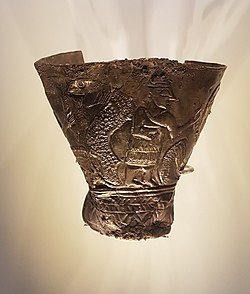Top Qs
Timeline
Chat
Perspective
'Ain Samiya goblet
Silver cup from the Middle Bronze Age I From Wikipedia, the free encyclopedia
Remove ads


You can help expand this article with text translated from the corresponding article in Hebrew. (March 2025) Click [show] for important translation instructions.
|
The 'Ain Samiya Goblet is a silver cup from the Middle Bronze Age I (2300-2000 BC), found in a tomb at Ain Samiya near modern Ramallah. It was discovered in 1970 at Khirbet el-'Aqibat, located just before Ein Samiya on the road to Kafr Malik.[1][2] An extensive cemetery had been previously known to cover three adjacent hills: Khirbet el-'Aqibat, Khirbet Samiya and Dhahr el-Mirz, the latter of which had been excavated in the 1960s by Paul W. Lapp, the Director of the American School of Oriental Research in Jerusalem.[1]
It depicts a double-headed god with an animal body planting crops and the dead body of a serpent, parts of whom are being held by two male figures. The scenes are purported to depict a proto version of the Babylonian creation epic, the Enuma Elish and the defeat of Tiamat by the Babylonian patron deity, Marduk.[3] The goblet demonstrates clear influences from Mesopotamia on Proto-Canaanite culture and shares other parallels with contemporary depictions like the Khafaje plaque during Babylonian captivity.[4][5]
Remove ads
References
Wikiwand - on
Seamless Wikipedia browsing. On steroids.
Remove ads



